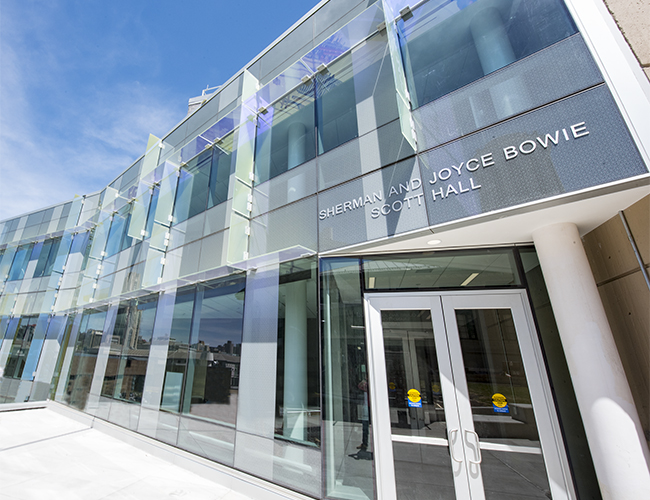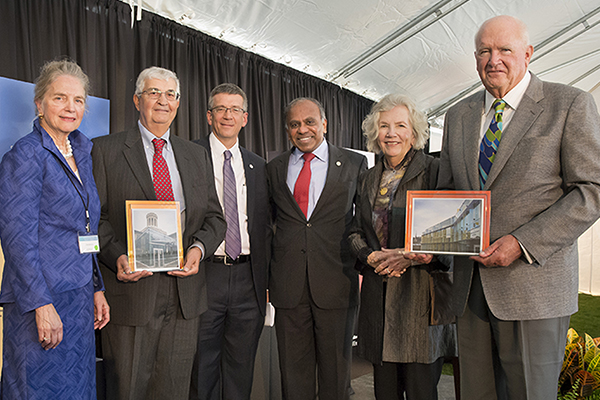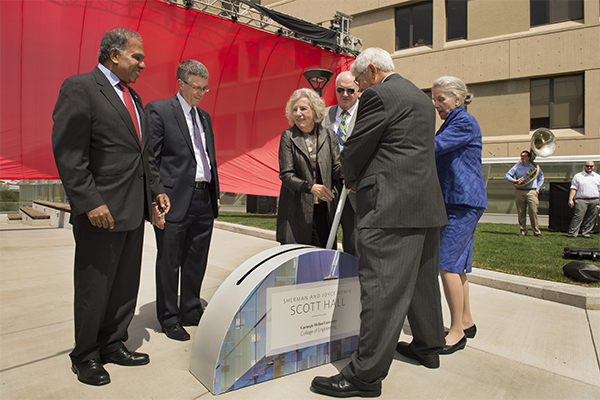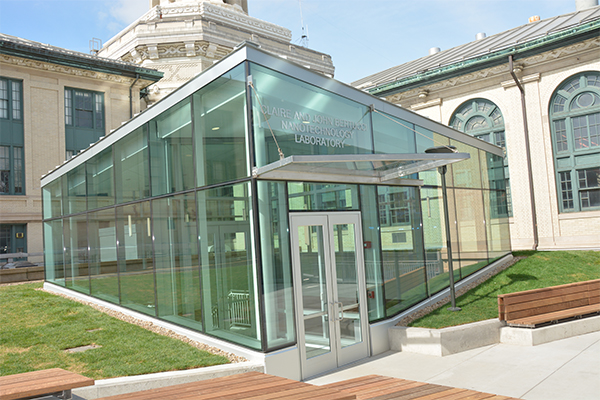Building Connections
Sherman and Joyce Bowie Scott Hall Opens Window to the World
By Emily Durham

Walking across the Forbes Avenue Junction Hollow bridge toward Carnegie Mellon University, the view is changing.
The Sherman and Joyce Bowie Scott Hall, dedicated on April 30, provides both visual and intellectual stimulation, enhancing the College of Engineering’s innovative culture and fostering interdisciplinary research.
Engineering always has had a “maker culture” of creating cutting-edge tools and products to benefit the modern world. With new lab space and new technologies, researchers and students can take that environment to a new level.

Pictured at the building dedication are (from left)
Sherman and Joyce Bowie Scott,President Suresh,
Dean Jim Garrett, and John and Claire Bertucci.
“Scott Hall will help us turn our maker culture into a maker ecosystem,” said Dean James H. Garrett Jr.
Like a puzzle piece, the building and its amenities connect fields of study and expand collaboration across CMU. Researchers and students have easier access to advanced technologies for turning ideas into reality.
The building is the new home for the Wilton E. Scott Institute for Energy Innovation, the Department of Biomedical Engineering, the Engineering Research Accelerator (formerly known as the Institute for Complex Engineered Systems), the Disruptive Health Technologies Institute and a nanotechnology research facility.

John Bertucci pulls the lever, dropping a curtain to
unveil the new building.
The 109,000-square-foot Scott Hall, designed by OFFICE 52 Architecture, has two main sections: the North Wing and the Claire and John Bertucci Nanotechnology Laboratory. They meet at the Arthur C. Ruge Atrium and the Collaboratory, a sweeping four-story space that connects the levels of the North Wing.
From Forbes Avenue, the North Wing is visible on angled white steel support columns strategically placed to avoid the utilities below. The glass, which creates the outer wall of the building, changes color as it reflects light from different angles throughout the day. As a nod to the nanofabrication work taking place within the walls, many of the windows include a design feature that represents a mathematical and nanoscience concept called photonic quasicrystal.

Entrance to the Bertucci Nanotechnology Lab is
through a glass pavilion tucked between
Porter, Hamerschlag, Roberts and Wean halls.
The Bertucci Nanotechnology Lab is tucked between Porter, Hamerschlag, Roberts and Wean halls, turning what was a small service and parking area into a large workspace. Its entrance is through a glass pavilion. Above the lab is a green roof with skylights to provide more space for work, camaraderie and relaxation inside and outside the building. The space is tied to the lawn of the Hornbostel Mall.
Within the lab is the 10,000-square-foot Eden Hall Foundation Nanofabrication Cleanroom, which will allow faculty and researchers to explore new avenues of nanoscience. Cleanrooms are tightly controlled environments that maintain concentrations of airborne particles within certain limits. The space will be completed this summer and fully operational in 2017.
With many other buildings nearby, Scott Hall becomes a new nexus on campus.
The Collaboratory and Ruge Atrium, which contains a café, are designed to encourage informal discussions to promote the types of collaborations that can lead to major breakthroughs.
“The building will physically bring together hundreds of faculty and students from a variety of disciplines, allowing them to work together in ways they had not been able to before,” Garrett said.
